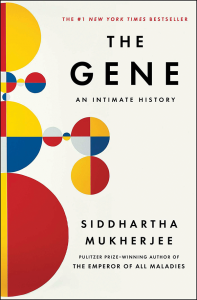The Gene: An Intimate History

BOOK BY SIDDARTHA MUKHERJEE
SCRIBNER, 2016
608PP.; $38.00
At first glance, The Gene: An Intimate History may not be the best book for light reading. In nearly 500 pages, with an additional hundred pages of acknowledgments, notes, and citations, Pulitzer Prize-winning author Siddartha Mukherjee (The Emperor of all Maladies: A History of Cancer) takes the reader on a heavily laden historical and biographical journey into how scientists began their understanding of the gene.
The most intriguing parts of the book are when Mukherjee discusses the inherited traits of his own family. Here he is in true memoir, discussing his uncles’ descents into schizophrenia and bipolar disorder, as well as a genetic disease his father acquired late in life—normal pressure hydrocephalus (NPH), which acts similarly to Alzheimer’s disease. The stories provide a fascinating look into the author’s family, as the author also invites readers to reflect on their own family’s heredity, the positives and negative traits we know are “passed down” through the generations and through our genes. Throughout, Mukherjee weaves his story alongside the story of the gene, creating his own literary double helix.
In many instances, the history of the gene is compelling and the author shows compassion for early investigators such as Charles Darwin and Joseph Mendel. He paints them with deep insight for their astonishing work that led to a revolution in the twentieth-century study of genetics. However, he also describes the irony that, during their own time, these great efforts were often discredited or completely ignored. Even Darwin sometimes doubted his own work, and Mendel, now a staple in Introduction to Biology classes, died in obscurity, described at death not as the patient, scrupulous scientist and inventor of the concept of alleles we now regard him as, but as “gentle, free-handed, and kindly.”
Mukherjee is excellent at pointing out these contrasts, along with the squabbling, rivalrous, and ill tempers that arose in twentieth-century science. Still, great leaps were made, such as the invention of insulin and Recombinant Factor VIII, by which a complex set of genes was cloned, inserted into a plasmid, and then introduced into a hamster’s ovary cells, creating a substitute for blood transfusions for hemophiliacs during the early days of the AIDS epidemic. Unlike gay men, who quickly organized and took steps to promote safe sex and close bathhouses, hemophiliacs had no choice but to die from bleeding or to die from AIDS. However, different corporations and universities raced against each other to be the first to find a solution for hemophiliacs. The geneticists at Gentech prevailed in 1983, introducing a new genetic compound that began saving thousands of hemophiliacs’ lives. In this case, competition was good for science and humanity, if not for the scientists who lost to Gentech.

Siddartha Mukherjee
Another interesting idea explored in The Gene is the evolution of eugenics and its application to individual decisions about aborting fetuses due to genetic deformities. Mukherjee rightly rebukes the efforts of racist and radical factions that jumped on the opportunity of “genetics” in classifying people based on poverty, lack of education, gender, and race. This led to permanent imprisonment of the victims and, soon after, forced sterilization. In Europe the concept of eugenics was even more vile, ultimately causing the egregious barbarity of World War II. However, Mukherjee notes that a different form of “genetic selection” arose in the United States in the 1970s. Once Roe v. Wade became law, women could choose to have abortions. Along with that decision were advances in genetic testing, thus allowing women and their doctors to have conversations about keeping a child that might, for example, have Huntington’s disease or a variety of other diseases with easily identifiable genetic defects. The book argues that, in some instances, abortion can be more humane than bearing a child who would certainly die either immediately or within months, often in abject misery.
In other cases, such as where children are born with Down syndrome or dwarfism, many can lead full, nearly independent lives. It is even more complex of a decision to abort if the disease varies in magnitude, such as with schizophrenia and autism, and may or may not present itself in any individual at all. If the disease does present itself, it can be devastating to the people with the condition and their family. However, there are many factors besides genetics that can contribute to the presence or severity of the disease, thus making that choice much more complicated. It is these sorts of moral conundrums that Mukherjee likes the reader to consider. It is also important that he does not decide the issues; instead, he presents the information and leaves the discussion open.
Finally, The Gene examines the ambitious Human Genome Project, which mapped the entire human genome sequence—over 3 billion sets of DNA. Mukherjee is adept and clear both in his science and descriptions of many of the competitive geneticists who worked with and around the project. At this point in the book, the success of the project feels like the climax of the story of the gene. Clearly, this is untrue. Mukherjee suggests that this is more of a true beginning in the science of genetics, and that many more achievements in its study and use will hopefully help the human race.
It is impossible to reveal every concept, scientific discussion, or question that Mukherjee presents to the reader. This is a strength of the book, as it is so comprehensive the author actually does attempt—and in many ways succeeds—at surveying all the advances, setbacks, potential problems, future successes, and limitations of understanding the human gene. His writing is often lyrical, and the passion to be both personal and comprehensive is clear. Even so, it can be overwhelming—not convoluted, but occasionally bogged down with excessive historical detail and analysis. That being said, The Gene accomplishes what it sets out to do—it maps the history of the gene, the smallest unit of all of us, and provides insight into its future.
